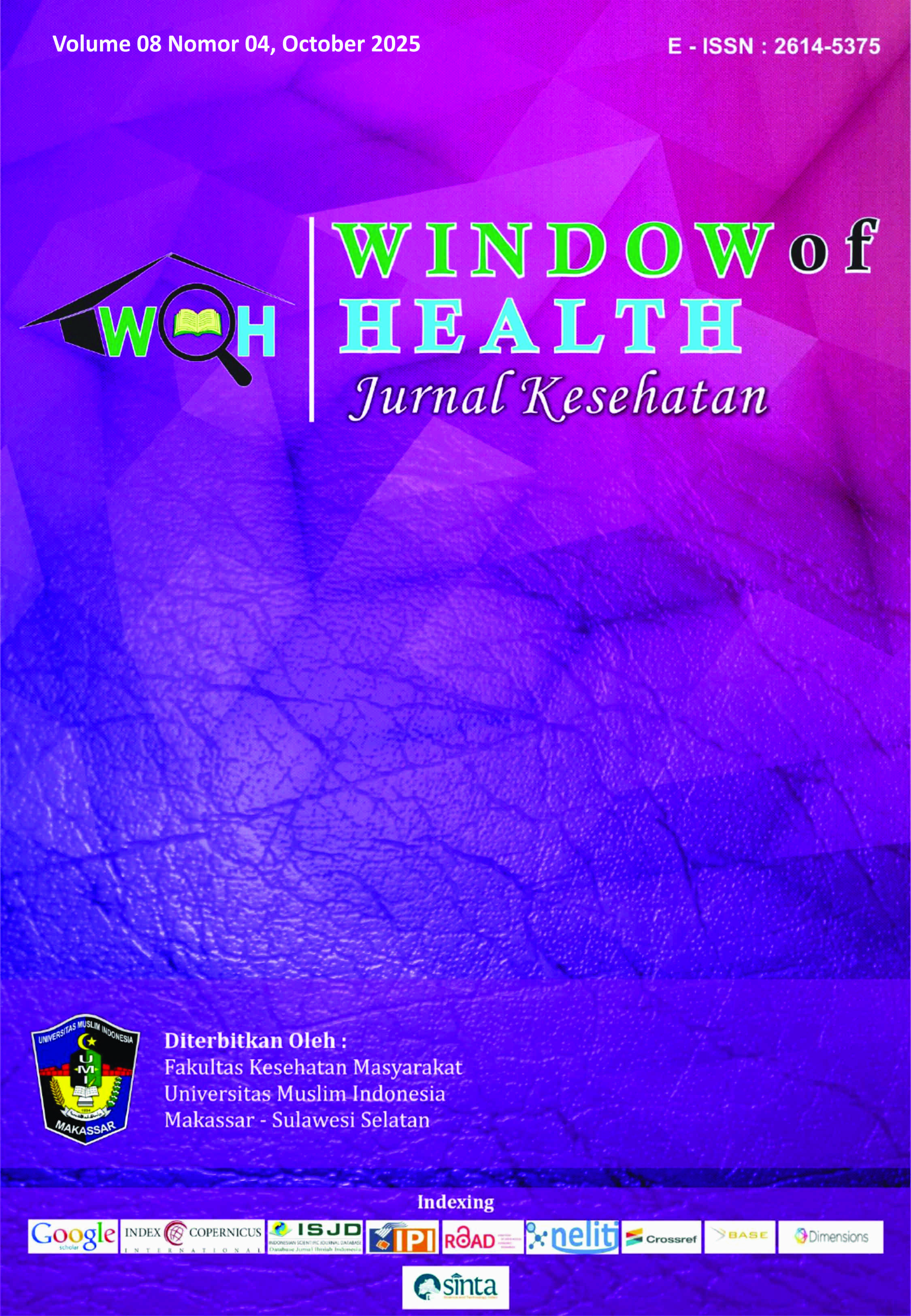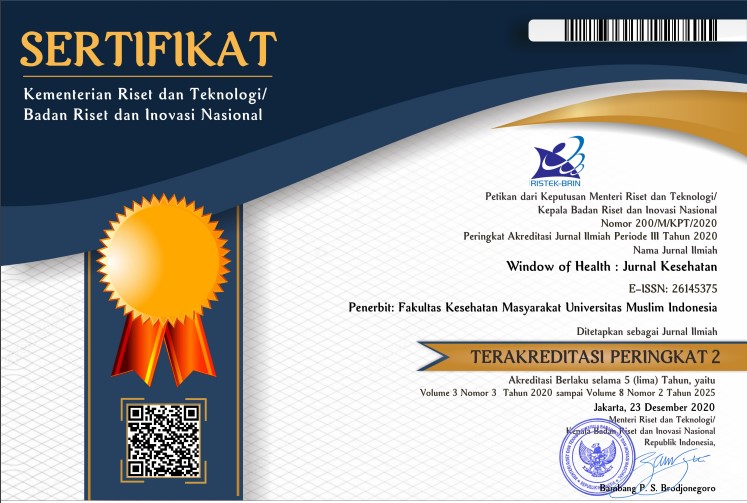The The Relationship between Nutritional Status and Worm Infection with the Intellectual Ability: A Case of Children Aged 6-12 Years in Jungkat Village
Abstract
The prevalence of worm infection in Indonesia remains high, reaching 21.6% in 2022, with significant impacts on children, including decreased cognitive function and growth impairments. Theoretically, children who are in high-risk environments for worm infection and delayed growth have a high potential to have low intelligence. This study aimed to describe the nutritional status, worm infection, and intellectual ability of elementary school children in Jungkat Village, and to analyze the interrelationships between these factors. A cross-sectional study was conducted in four elementary schools in Jungkat Village from June to August. A total sampling approach was applied, with 626 children aged 6–12 years who met the inclusion criteria (enrolled in the schools and obtained parental consent). Data were collected via anthropometric measurements, a worm infection questionnaire, and Raven’s Progressive Matrices (RPM), and analyzed using multinomial logistic regression. More than 70% of children had a normal nutritional status, but stunting (20.78%), overweight (7.67%), and obesity (7.67%) indicated a dual burden of malnutrition. The prevalence of worm infection is notably high (29.71%), while intellectual assessments indicate that 60.86% of children fall into the below-average or defective categories. Interestingly, children in Jungkat Village appear to adapt to worm infections, as these do not seem to impair intellectual capacity. Despite having a mostly normal nutritional status, many individuals still demonstrate below-average intellectual abilities, suggesting that other determinants, beyond nutrition and infection, may play a stronger role. Further studies are recommended to explore genetic, environmental, and educational factors that may influence children’s intellectual development.
References
Nshimiyimana L, Mbonigaba JB, Mbituyumuremyi A, Ower A, Hakizimana D, Nyandwi E, et al. Remapping parasite landscapes: Nationwide prevalence, intensity and risk factors of schistosomiasis and soil-transmitted helminthiasis in Rwanda. PLoS Negl Trop Dis [Internet]. 2025 Aug;19(8):e0013328. Available from: http://www.ncbi.nlm.nih.gov/pubmed/40853975
Mao F, Xu X, Tang F, Ni B, Zhang Q, Zhang J, et al. Unveiling the disparities between private and public preschools in the risk for pinworm infections in China: a multicentre cross-sectional study. BMC Public Health. 2025 Dec 1;25(655).
Brooker S. Spatial Epidemiology of Human Schistosomiasis in Africa: Risk Models, Transmission Dynamics and Control. Trans R Soc Trop Med Hyg. 2007 Jan;101(1):1–8.
Hajare ST, Gobena RK, Chauhan NM, Eriso F. Prevalence of Intestinal Parasite Infections and Their Associated Factors among Food Handlers Working in Selected Catering Establishments from Bule Hora, Ethiopia. Biomed Res Int. 2021 Jan 20;2021(1).
Acka CA, Raso G, N’Goran EK, Tschannen AB, Bogoch II, Séraphin E, et al. Parasitic Worms: Knowledge, Attitudes, and Practices in Western Côte d’Ivoire with Implications for Integrated Control. PLoS Negl Trop Dis. 2010 Dec 21;4(12):e910.
Dhaka R, Verma R, Parmar A, Chayal V, Kalhan M, Bhalla K, et al. Association between the Socioeconomic Determinants and Soil-transmitted Helminthiasis among School-Going Children in a Rural Area of Haryana. J Family Med Prim Care. 2020;9(7):3712.
WHO. Soil-transmitted Helminth Infections. https://www.who.int/news-room/fact-sheets/detail/soil-transmitted-helminth-infections/. 2023 Jan 18;
Crompton DWT, Nesheim MC. Nutritional Impact of Intestinal Helminthiasis During the Human Life Cycle. Annu Rev Nutr. 2002 Jul;22(1):35–59.
Bleakley H. Disease and Development: Evidence from Hookworm Eradication in the American South. Quarterly Journal of Economics. 2007 Feb;122(1):73–117.
Hotez PJ, Brindley PJ, Bethony JM, King CH, Pearce EJ, Jacobson J. Helminth infections: the great neglected tropical diseases. Journal of Clinical Investigation. 2008 Apr 1;118(4):1311–21.
Mardiana, Djarismawati. Prevalensi Cacing Usus pada Murid Sekolah Dasar Wajib Belajar Pelayanan Gerakan Terpadu Pengentasan Kemiskinan Daerah Kumuh di Wilayah DKI Jakarta. Jurnal Ekologi Kesehatan. 2005 Aug 18;7(2):769–74.
Sapada E, Asmalinda W. Environmental sanitation factors as prevalence support of soil transmitted helminths. Int J Publ Health Sci. 2021 Dec 1;10(4):834–42.
Nur NH, Kartini K, Arda ZA. Worm Infections (Soil-Transmitted Helminthiasis) in Elementary School Students. Poltekita : Jurnal Ilmu Kesehatan. 2023 Oct 26;17(3):515–20.
Pasaribu AP, Alam A, Sembiring K, Pasaribu S, Setiabudi D. Prevalence and Risk Factors of Soil-Transmitted Helminth among School Children Living in an Agricultural Area of North Sumatera, Indonesia. BMC Public Health. 2019 Aug 7;19(1).
Patlán‐Hernández AR, Stobaugh HC, Cumming O, Angioletti A, Pantchova D, Lapègue J, et al. Water, Sanitation and Hygiene Interventions and the Prevention and Treatment of Childhood Acute Malnutrition: A Systematic Review. Matern Child Nutr. 2022 Jan 6;18(1).
Kundaian F, Umboh JML, Kepel BJ, Kesehatan F, Universitas M, Manado SR. Hubungan Antara Sanitasi Lingkungan dengan Infestasi Cacing pada Murid Sekolah Dasar di Desa Teling Kecamatan Tombariri Kabupaten Minahasa. KESMAS: Jurnal Kesehatan Masyarakat Universitas Sam Ratulangi. 2012;1(1):21–7.
Murni. Perkembangan Fisik, Kognitif, dan Psikososial pada Masa Kanak-kanak Awal 2-6 Tahun. International Journal of Islamic Studies. 2017;3(1):19–33.
Sunarpo JH, Ishartadiati K, Al Aska AA, Sahadewa S, Sanjaya A. The Impact of Soil-Transmitted Helminths Infection on Growth Impairment: Systematic Review and Meta Analysis. Healthc Low Resour Settings. 2023 Nov 9;11(2).
Raven JC. Standard Progressive Matrices Sets: Sets A, B, C, D and E (Revised Order 1956). London: HK Lewis & Co., Ltd.; 1956.
Vass VA. Standardization of Raven’s Standard Progressive Matrices for Secondary School African Pupils in the Grahamstown Region [Thesis]. Rhodes University; 1992.
Kementerian Kesehatan Republik Indonesia. Profil Kesehatan Indonesia 2022. Jakarta; 2023.
WHO. Classification of Nutritional Statys of Infants and Children. Switzerland; 2017.
Venables W, Ripley B. Modern Applied Statistics with S 4th Edition. Springer ; 2002.
De Silva Angela, Rani Manju. The Double Burden of Malnutrition: Priority Actions on Ending Childhood Obesity. World Health Organization. Regional Office for South-East Asia; 2020. 100 p.
Lerm BR, Crochemore-Silva I, Costa JC, Victora CG. The Double Burden of Malnutrition in Under-five Children at National and Individual Levels: Observed and Expected Prevalence in Ninety-three Low- and Middle-Income Countries. Public Health Nutr. 2021 Jul 1;24(10):2944–51.
Steyn NP, Nel JH. Prevalence and Determinants of the Double Burden of Malnutrition with a Focus on Concurrent Stunting and Overweight/Obesity in Children and Adolescents. Curr Nutr Rep. 2022 Jun 18;11(3):437–56.
UNICEF, WHO, World Bank. Levels and Trends in Child Malnutrition: UNICEF/WHO/World Bank Group Joint Child Malnutrition Estimates Key Findings of the 2023 Edition. 2023.
WHO. Intellectual Disability. 2019; WHO-EM/MNH/221/E. Available from: www.emro.who.int/mnh.
Di Blasi FD, Buono S, Cantagallo C, Di Filippo G, Zoccolotti P. Reading skills in children with mild to borderline intellectual disability: a cross‐sectional study on second to eighth graders. Journal of Intellectual Disability Research. 2019 Aug 15;63(8):1023–40.
Grantham-McGregor S, Cheung YB, Cueto S, Glewwe P, Richter L, Strupp B. Developmental Potential in the First 5 Years for Children in Developing Countries. The Lancet [Internet]. 2007 Jan;369(9555):60–70. Available from: https://linkinghub.elsevier.com/retrieve/pii/S0140673607600324
Victora CG, Adair L, Fall C, Hallal PC, Martorell R, Richter L, et al. Maternal and Child Undernutrition: Consequences for Adult Health and Human Capital. The Lancet [Internet]. 2008 Jan 26;371. Available from: http://www.cpc.unc.
Puspita WL, Khayan K, Hariyadi D, Anwar T, Wardoyo S, Ihsan BM. Health Education to Reduce Helminthiasis: Deficits in Diets in Children and Achievement of Students of Elementary Schools at Pontianak, West Kalimantan. J Parasitol Res. 2020 Jul 21;2020:1–7.
Tapiheru MJR, Zain N. Prevalensi Infeksi Soil Transmitted Helminth pada Murid Sekolah Dasar Negeri 105296 Kecamatan Percut Sei Tuan, Kabupaten Deli Serdang, Sumatera Utara. JIMKI: Jurnal Ilmiah Mahasiswa Kedokteran Indonesia. 2021 Feb 21;8(3):1–7.
Rahma NA, Zanaria TM, Nurjannah N, Husna F, Putra TRI. Faktor Risiko Terjadinya Kecacingan pada Anak Usia Sekolah Dasar. Jurnal Kesehatan Masyarakat Indonesia [Internet]. 2020 Nov;15(2):29–33. Available from: https://jurnal.unimus.ac.id/index.php/jkmi,
Subair H, Hidayanti H, Salam A. Gambaran Kejadian Kecacingan (Soil Transmitted Helmith), Asupan Vitamin B12 dan Vitamin C pada Anak Usia Sekolah Dasar di Kota Makassar. Jurnal Gizi Masyarakat Indonesia: The Journal of Indonesian Community Nutrition. 2019 Aug 20;8(1).
Prado EL, Dewey KG. Nutrition and Brain Development in Early Life. Nutr Rev. 2014 Apr;72(4):267–84.
Kar BR, Rao SL, Chandramouli BA. Cognitive development in children with chronic protein energy malnutrition. Behavioral and Brain Functions. 2008 Jul 24;4.
Walker SP, Chang SM, Powell CA, Grantham-McGregor SM. Effects of Early Childhood Psychosocial Stimulation and Nutritional Supplementation on Cognition and Education in Growth-Stunted Jamaican Children: Prospective Cohort Study. The Lancet. 2005 Nov;366(9499):1804–7.
WHO. Malnutrition. https://www.who.int/news-room/fact-sheets/detail/malnutrition. 2024;
Watkins WE, Pollitt E. “Stupidity or Worms”: Do Intestinal Worms Impair Mental Performance? Psychol Bull. 1997 Mar;121(2):171–91.
Stephenson LS, Latham MC, Ottesen EA. Malnutrition and parasitic helminth infections. Parasitology. 2000 Oct 15;121(S1):S23–38.
Hall A, Hewitt G, Tuffrey V, De Silva N. A Review and Meta-Analysis of the Impact of Intestinal Worms on Child Growth and Nutrition. Matern Child Nutr. 2008;4:118–236.
Ezeamama AE, Friedman JF, Acosta LP, Bellinger DC, Langdon GC, Manalo DL, et al. Helminth Infection and Cognitive Impairment among Filipino Children. American Journal of Tropical Medicine and Hygiene. 2005 May;72(5):540–8.
Kamila AD, Margawati A, Nuryanto N. Hubungan Kecacingan dengan Status Gizi dan Prestasi Belajar -pada Anak Sekolah Dasar Kelas IV dan V di Kelurahan Bandarharjo Semarang. Journal of Nutrition College. 2018 May 30;7(2):77.
Handayani D, Ramdja M, Fitri Nurdianthi I. Hubungan Infeksi Soil Transmitted Helminths (STH) dengan Prestasi Belajar pada Siswa SDN 169 di Kelurahan Gandus Kecamatan Gandus Kota Palembang. Majalah Kedokteran Sriwijaya. 2015;47(2):91–6.
Cameron L, Chase C, Haque S, Joseph G, Pinto R, Wang Q. Childhood Stunting and Cognitive Effects of Water and Sanitation in Indonesia. Econ Hum Biol. 2021 Jan;40:100944.
Setiyawati D, Situmeang SM. Hubungan Infeksi Soil Transmitted Helminths (STH) dengan Prestasi Belajar Anak SD Perguruan Pahlawan Nasional Medan. Jurnal Mitra Prima. 2023 Oct;5(2).
Buntoro I, Deo D, Woda R. The Impact of Nutrition, Helminth Infection, and Lifestyle on Elementary School Student’s Achievement. J Trop Life Sci. 2017 Jan 31;7(1):30–3.
Sakti H, Nokes C, Hertanto WS, Hendratno S, Hall A, Bundy DAP, et al. Evidence for an association between hookworm infection and cognitive function in Indonesian school children. Tropical Medicine and International Health. 1999;4(5):322–34.
Ye C, Zhang L, Tang L, Duan Y, Liu J, Zhou H. Host Genetic Backgrounds: The Key to Determining Parasite-Host Adaptation. Front Cell Infect Microbiol. 2023 Aug 10;13:1228206.
Copyright (c) 2025 Wolly Candramila Wolly Candramila, Yulia Kurniati, Asriah Nurdini Mardiyyaningsih

This work is licensed under a Creative Commons Attribution-NonCommercial-ShareAlike 4.0 International License.








